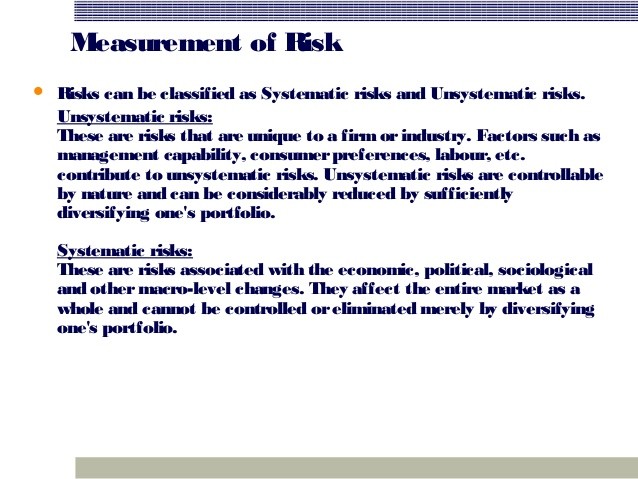Risk Measurement and Management Systematic Investment Risk Profile and High Risk Investments
Post on: 15 Июнь, 2015 No Comment

All of us want to increase our returns on investments. However, such returns are commensurate with the risks that we are willing to take. In other words, high risks entail higher returns. It is up to each individual to assess their risk profile to manage their investments better.
Some rules of thumb to help decide our risk profile include the amount available for investment, the age of the investor and the family circumstances of the investor.
If the amount available for investment is greater, then a higher proportion of funds can be allocated to high-risk investments that offer high returns. This will still leave sufficient funds in low-risk instruments such as the debt market were the principal is not under risk.
Another factor that helps decide the risk proportion is the age of the investor. Younger investors can typically afford to risk a larger share of their corpus as they have a longer period to recoup any losses they make due to incorrect investment decisions.
Family circumstances, such as the number of dependents, too matter when deciding on an acceptable risk profile. An investor with many dependents and who needs large sums in the immediate future to meet family commitments should opt for a greater exposure in low-risk investments. On the other hand a member of todays double income family can safely increase their risk profile and opt for a more aggressive investment strategy .
High-risk investments include stocks and shares. However, the investor will have to bear in mind that the stock market can be a hard paymaster and the risk of capital erosion is greater. One should exercise great care and complete a through due diligence of the company under consideration, read its balance sheet. enquire about its future plans, assess the viability of such plans in the current economic scenario and only then invest in its shares.
Investors who are unable to examine each company report thoroughly should consider investing in the secondary market through mutual funds. The profile of such funds should be examined and the selection should be based on the debt to equity ratio offered by the fund. The antecedents of the fund manager too matter when choosing a mutual fund.
Another way to hedge investments in the stock market is to use the systematic investment plan either directly in the stock market or through a mutual fund. Many studies have shown that a systematic investment (or investing a fixed sum each month) averages out the risks over a long period of time and offers good returns.

All investors, even those who prefer to follow an aggressive investment strategy. should hedge their risks by allocating some funds to debt instruments such as fixed deposits (especially in banks and the bond or money markets ), gold, non-speculative real estate and so on.
Though younger investors and those with a large corpus can afford to invest a greater proportion of the funds available in high-risk areas. middle aged and older people as well as those with a smaller nest egg should put a larger share of the money available in low-risk instruments. This is because people with a smaller surplus available for investment are also those that cannot afford to lose their principal. The middle aged and older people have a greater call on their resources at this age and need to be able to lay their hands on the principal easily.
As retirement beckons, the investor needs to shift their profile from one of high risk to that of a low risk one. Post retirement the investor needs to move almost completely to very low risk instruments such as sovereign rated debt.
Having said this, investment decisions should also be based on the individuals personal willingness to risk their principal in high-risk instruments or opt for a low-risk safe one. Risk management is ultimately a deeply personal issue that should be based on sound, informed decisions














